Anime: Grave of the Fireflies — Story of Survival, World War II
Grave of the Fireflies Recommended ages: 8 and up.
Synopsis
In the waning days of World War II, American bombers drop napalm canisters on Japanese cities, creating fire storms. These bombs, longer than a tin can but about as big around, fall to earth trailing cloth tails that flutter behind them; they are almost a beautiful sight. After they hit, there is a moment’s silence, and then they detonate, spraying their surroundings with flames. In a Japanese residential neighborhood, made of flimsy wood and paper houses, there is no way to fight the fires.
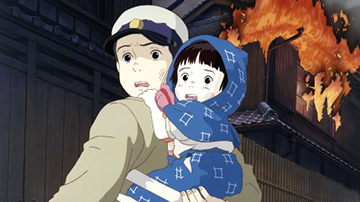
Toward the beginning of this elegiac and riveting video, Seita, who is 14, and his 4-year-old sister, Setsuko, sift through the rubble of Kobe, Japan, left heavily damaged by American firebombs. “Grave of the Fireflies,” a 1988 Japanese video with English subtitles, was recently released in the United States. The animated story, about two children orphaned at the end of World War II, is not for every child. Based on an autobiographical novel by Akiyuki Nosaka, the video, with its muted, delicate colors, almost like a Japanese brush painting, softens the ugly reality the children face. After their mother dies (as she dies, she is shown wrapped in bloody bandages), they eventually settle in an abandoned bomb shelter.
From there, they scavenge food, which is scarce for nearly everyone. At one point, Seita steals tomatoes from a farm and is beaten. Setsuko becomes delirious from starvation, and in the last scenes her brother tries to sustain her.
The 88-minute video is indeed sad, but it also shows the siblings’ determination and love. One young viewer was fascinated by the war and by the scenes showing the children eating with chopsticks, sitting on folded legs at a low table. This young viewer also had a lot of questions afterward, as his mind worked to grasp what he had seen.
Background
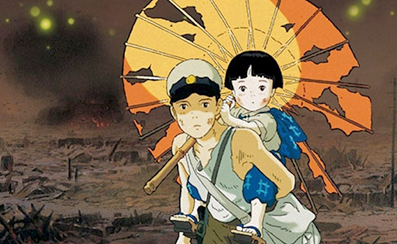
This is based on a review of a Studio Ghibli animation film, “Grave of the Fireflies” (1988) directed by Isao Takahata, who has made other animation films, including “Only Yesterday”(1991), “Pom Poko” (1994), “My Neighbors the Yamadas” (1999), and “The Tale of Princess Kaguya” (2013). The making of the film was inspired by a novel of the same title, written by Akiyuki Nosaka, on the basis of his own war experience, and published in 1968. Nosaka was born in 1930 and adopted in Kobe, but his foster father died and his foster mother was seriously burned due to the fire-bombing of Kobe in June 1945. Therefore, his novel “Grave of the Fireflies” is categorized as ‘war literature’ that depicted “adolescence under the wartime”. This film was released on the same day with Director Miyazaki’s “My Neighbor Totoro” (1988) and might have influenced Miyazaki’s animation film, “The Wind Rises” (2013) that portrayed the inter-war period between the two world wars and the life of Jiro Horikoshi, a designer of the Mitsubishi M6 Zero Fighter. In a way, these two war related movies animated by Studio Ghibli are connected to each other just as a cause-and-effect relationship in that the Japanese zero fighters were used in the Pacific War, especially in the attack on Pearl Harbor on 7 December 1941 that eventually led to the air raids on Japanese mainland, including the fire-bombing of Kobe, which became a motif for “Grave of the Fireflies”. Director Takahata as well as Akiyuki Nosaka commented that this story was not an ‘anti-war’ work, but played an effective role in handing down the ‘memory of war’ from the Second World War in Japan to the next generations. Usually, animation films are apt to be nothing more than entertainment in which truth may be portrayed from an unrealistic angle. Nonetheless, Director Takahata’s film ‘Grave of the Fireflies’ provides realistic details of the process in which two children, a brother and a sister, suffer and die from hunger and malnutrition because of war. Accordingly, as Tadao Sato pointed out, the work values the realism of the war experience. Yet, more importantly, pointed to the enigma of “why the children died in the film?” Yonaha stressed the importance of exploring this question so as not to forget Japan’s war memory. The central question in this paper is “why did the children have to die?” In other words, the question of “who is really responsible for their deaths?” is systematically examined in a methodological application of peace research. The implications of this research in peace education will be discussed thereafter.
Discussion
Physical, psychological and structural violence of war:
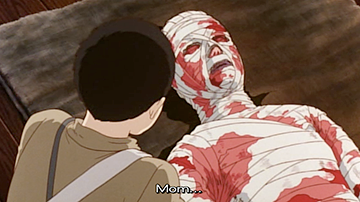
The concept of‘direct/indirect violence’ is implied within the depicted typology. Director Takahata as well as some other observers, such as Toshio Okada argued that this animated film is not an ‘anti-war film’. Indeed, they may be described as ‘war film’ or ‘war-related film’ instead of ‘anti-war film’ to avoid the nuance of ‘anti & war propaganda’. Nonetheless, the analytical process of the physical/psychological/structural violence in this review reveals whether this film may be classified as an ‘anti-war film’ or not. Finally, the implication of the film for peace education at home, school, and in the world will be explored.The main character is a 14 year old boy, Seita, who tries to look after his four year-old sister after their mother dies due to the bombing of Kobe in the middle of the Asia Pacific War. Right from the beginning, the movie lets the audience know that the main character, Seita is already dead and he starts narrating what happened to him and his sister under the war: “I died on 21 September 1945”. When he passes away, fireflies, which usually die quickly, are flying around his body, symbolizing the brevity of the lives of Seita, The dead bodies in the train station are caused by‘direct and physical violence’ in the bombing of Kobe. The first air-raid attack by American B-25 Mitchel bombers on Japanese mainland was led by Lieutenant Colonel James Doolittle on 18 April 1942, about four months after the attack on Pearl Harbor, also known as the ‘Doolittle Raid’. The Doolittle Raid targeted not only Kobe city, but also Tokyo, Kawasaki, Yokosuka, Nagoya, and Yokkaichi on the same day. Lieutenant Colonel Doolittle received a medal of honor for his leadership. In the first phase (early November 1944 to mid-March 1945, B-29 bombers conducted the so-called ‘precision bombing’ of aircraft factories as well as ‘area bombing’ of industrial cities. In the second phase (mid- March to 15 August 1945), indiscriminate area bombings killed a large number of civilians. At the same time, the United States dropped a mock & atomic bomb on Kobe harbor to prepare for atomic bombing. Major air-raids were conducted on 17 March, 11 May, and 5 June and killed more than 8,000 civilians. On 5 June 1945, 474 B-29 bombers conducted an air-raid on Kobe from 7:22am to 8:47am (Kobe City Archives, 2004; Ministry of Internal Affairs, Japan, 2010), which became a motif for “Grave of the Fire Flies”.
Peace education through the animated film “Grave of the Fireflies”
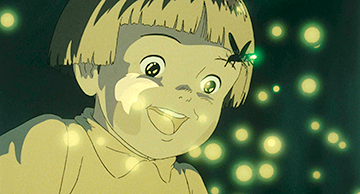
Physical, psychological & structural violence of war: Psychological violence: Seita, Setsuko and their aunt in ‘war of all against all’ The film depicts not only the terror of the war but also the ugliness of humans who used ‘psychological violence’. After the death of their mother, Seita and Setsuko virtually became ‘war orphans’ because their father was serving in the Japanese navy and did not drop a line to them. Seita and Setsuko were able to stay at a distant relative’s house, but their aunt treated them as a nuisance. For instance, the aunt suggested that Seita and Setsuko should sell their mother’s kimono in order to buy rice. When Setsuko cried at night, the aunt told Seita off for the noise. In the daytime, Seita had to take care of Setsuko but the aunt ironically told Seita that he should make a contribution to the country by going to school or work. What the aunt meant was that all the citizens should make contributions to the ‘war’. In the dinnertime, the aunt did not serve rice to them, whereas her family members had better meals. In the morning, the aunt made rice balls for her family’s lunch, but not for Seita and Setsuko. Setsuko complained that the rice belonged to the siblings in exchange for their mother’s kimonos, but the aunt replied that they already finished the rice and suggested that they should have meals separately, that her family members contributed to the country, and hence, they deserved the rice. Again the aunt used the ‘contribution’ to the country (war) as excuse to mentally abuse the siblings.
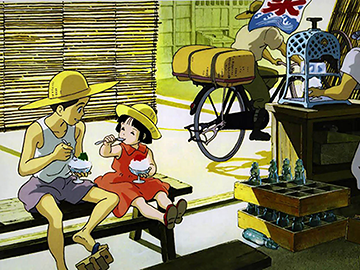
Finally, Seita makes up his mind to leave the aunt’s house and to live on their own. This part of the movie narrates the negative aspect of human nature rather than the horror of the Asia Pacific War. In a way, the relationship between Seita/Setsuko and the aunt can be regarded as a war among human beings, described by Thomas Hobbes (1962) as ‘war of all against all’, a state in which human beings are wolves to each other. Indeed, Director Takahata utilized a similar metaphor for humans and wolves in a state of war or during natural disaster in which humans can be demons to each other, the ‘war’ between Seita and his aunt was asymmetrical and more like ‘bullying’). Also, it is important to note that the aunt’s language and behavior are under the influence of war which makes humans insane. Clearly, this section depicts how humans conduct ‘psychological violence’ in order to survive and protect their own families and turn their backs on others’ misery. Seita and Setsuko might not know the difficulty to live on their own, but the aunt must know what would happen if the two children tried to live by themselves in that period. The worst thing the aunt did was to ‘suggest’ for Seita and Setsuko to live in a shelter outside and ‘deliberately’ not to dissuade the siblings from leaving her house. In this respect, it can be argued that the aunt is responsible for the death of the siblings. The author of the novel, Nosaka, as an actual figure, was not treated badly, but the story tells the memory of ‘war orphans’ who lost their parents as a result of the war.
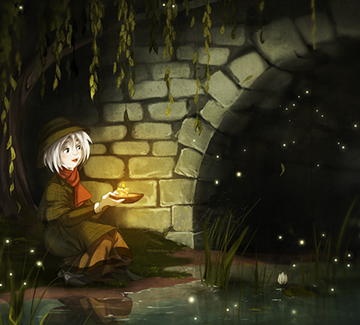
According to the survey conducted by the Ministry of Health and Welfare of Japan under the US occupation, the Asia Pacific War caused as many as 123,500 war orphans in Japan (Kaneda, 2013: 22). In some cases, war orphans were taken care of as adopted children, but they tended to be sold for prostitution, treated like slaves, and eventually abused to death. This is the reason why many war orphans ‘escaped’ from the houses of their relatives or foster families just like Seita and Setsuko. However, the war orphans had no choice but to become homeless, to be called germs and to die in train stations or elsewhere. Although the film is fictionalized based on Nosaka’s own experience, the aunt’s psychological violence against the siblings brings back the memory of war orphans who were forsaken or abused by their relatives or foster parents. Structural violence: who is responsible for their deaths? Third, the film shows audience how the two children were victimized not only by the war but also by an unfair and unjust social structure under the influence of the war. Therefore, it can be argued that they were killed by ‘structural violence’ that gradually killed the war orphans. At first, their new life in an air-raid shelter seemed to be adventurous and enjoyable like a camping trip, but as time passed, Setsuko started suffering from diarrhea and skin problems caused by malnutrition. To feed Setsuko, Seita started stealing vegetables from the neighbor’s field and was finally caught and brutally punched by the owner. Here, the film shows an asymmetrical, ‘physical bodily violence’ against a 14 year old boy by a male adult representing ‘war among all against all’ between the weaker and the stronger. Structural violence may thus result in more direct physical violence, killing the weakest in the society. Economic inequity stemming from structural violence undermined the health condition of Setsuko. When Seita took Setsuko to a hospital, a doctor told him to feed her with nourishing food. This scene simply indicates that there was nothing Seita could do for Setsuko without money and the doctor had to overlook the tragedy of the poor siblings. Despite Seita’s desperate endeavors, Setsuko finally died of malnutrition and Seita incinerated his sister’s body by himself. Eventually, Seita suffered from malnutrition and died as a war orphan at the end of the film. In this way, the social structure devastated by the war led to the deaths of the siblings, and thus ‘structural violence’ can be identified in the film. Some analysts, for instance Okada, have suggested that Seita was responsible for the death of Setsuko, because he made the final decision to leave the aunt’s house for his pride.
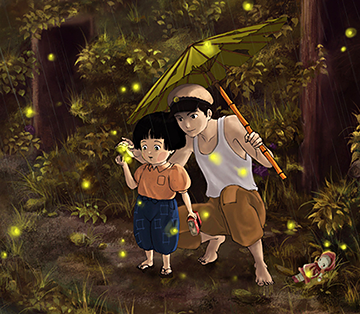
It is logical to consider that if Seita tolerated humiliating words by the aunt, it was likely that Setsuko would not need to die of malnutrition. The author of the story, Akiyuki Nosaka might have felt guilty for having to let his little sister die and the sense of guilt was reflected in the story. Nevertheless, it is fair to argue that the aunt forced the siblings to leave her house, and they were only minors who would not have sufficient knowledge, capacity for judgment, and ability to survive on their own. In the original novel version, Nosaka depicted that Seita had money but did not know how to buy stuff at the black market. In a live-action version of the film, the daughter of the aunt emotionally says that her mother ‘killed’ the siblings; still, the aunt had lost her husband and her family needed to survive at the sacrifice of the lives of children under war circumstances. In the live-action version, the war burned humans, cities, and humans’ hearts are noted. On account of the war devastation, the policy-makers of Imperial Japan could not take appropriate action to save 123,500 war orphans in the country. In this regard, the social structure was too devastated and dysfunctional for war orphans to survive under such circumstances.

Accordingly, not only Seita and the aunt, but also the owner of the field who punched Seita, the police who saw the desperate situation of the siblings, and the doctor who diagnosed Setsuko’s health condition, forsake Seita and Setsuko in some way. In other words, ‘structural violence’ caused by war is to blame for the tragic deaths of the siblings. Needless to say, decision-makers of the Empire of Japan that started the war and those of the United States who conducted air-raids and victimized civilians were responsible in the first place. Implications for peace education at school, at home, and in the world. As its original novel, the film “Grave of the Fireflies” can be utilized as teaching material in peace education, because one of the important agendas of education is to teach the war memory to children. Some analysts observe that this story is like a textbook to teach children about war. The original novel by Akiyuki Nosaka can be used as material for peace education, after watching the movie. Nosaka himself noted that the animated version of the story was more effective than his original novel. Mitsuharu Dannno observed that the film shed light on the brother and sister love as a Peace education through the animated film. The original novel showed the nihilism of the black market where Seita died. Compared to ordinary Japanese animation films, it is fair to argue that this work is designed not for entertainment but for education. Simply, the audience might feel that if it were not for the war, Seita and Setsuko, as innocent civilian children, did not have to die like that.
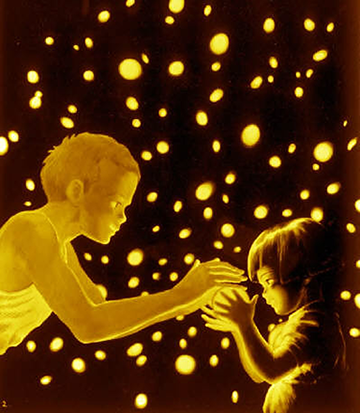
Just as other Studio Ghibli animation films, this film can be part of educational material at college level. For example, the author has offered an analysis on the implication of the film for war and peace in the classroom of peace education at Soka University (Akimoto, 2013a). Since there are only a few war films that focus on children in wartime (Saito, 2013: 159), students at school might benefit from a feeling of closeness towards Seita and Setsuko. Although Director Takahata mentioned that the film is not an anti-war film, he also realized that this film could be accepted as an anti-war film by the audience, especially children. For instance, after watching this film, elementary school students expressed their anti-war sentiments saying that they felt sorry for Seita and Setsuko and that war is scary and tragic, and that war should never be repeated. In addition to the comments by elementary school students, it was noted that the male students of junior high school cried aloud right in front of the screen at the theater. Likewise, the film can be watched at home as part of domestic peace education. Special consideration and parental guidance are required for the intense and violent scenes, but it is a very important peace education material at home. In fact, this film is categorized as one of the war and peace related movies for peace education at school and home. Seiichi Ueda for example suggested that mothers and children should watch the film together at home to consider war and peace issues. Ueda categorized the film “Grave of Fireflies” among war and peace related animation films in the same list with the famous anti-war/anti-nuclear film, “Barefoot Gen” by Kenji Nakazawa. Indeed, “Grave of Fireflies” has been broadcast on TV especially in Kinyō Roadshow. Hisae Kido showed her son, a nursery school toddler, this film; although her son probably could not figure out the war and peace issue, Kido learned a different angle of the film. By watching the film, not only children, but also mothers can educate themselves so that they could remember the war and teach their children the war memory. This film contains violence and traumatic scenes, especially dead bodies covered with maggots, and therefore, adult guidance would be necessary for younger audience at homes and schools. The author watched the film at the age of eight with a teacher and other students in the classroom of an elementary school. It may be shocking and even traumatic for elementary school students to watch animated dead bodies, but the author and other classmates found the film very educational as an anti-war animation film. There are no battle scenes in the film, and therefore, the film does not contribute to military education, but to peace education.
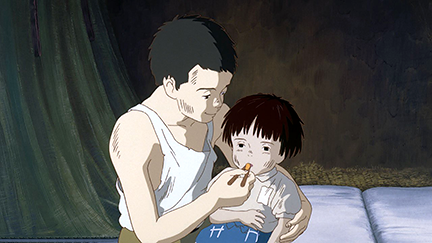
As a peace education material, this movie can convey the horror of war so that students can remember the Asia Pacific War. Some analysts argue that the Japanese Peace Constitution, especially Article 9 as an anti-war clause, should be protected. In the first place, Director Takahata is a strong constitutional protector. Anti-war pacifism of Takahata is much more thorough than that of Director Miyazaki who recognizes the importance of the dispatch of Japanese Self-Defense Forces to international peace operations, whereas Takataha opposes it on the basis of the Peace Constitution. Director Takahata argues that Japan has been able to avoid militarily involvement in US-led wars because of Article 9, and therefore, he contends that peace in Japan has been guaranteed by Article 9. Takahata moreover admits that it is natural for audience to regard his film “Grave of the Fireflies” as an anti-war message, hence, the utilization of the film in peace education could be politicized by educators. Nonetheless, the implication of the film is anti&war and for peace rather than a certain political message. Students might recognize the significance of Article 9 after watching this film. Regardless of the political stance of educators or parents, children are likely to understand the horror of war and the significance of peace. This film can be utilized as peace education material everywhere, as it has been widely recognized worldwide. It has received a number of international awards and has been broadcast for more than 20 years in France. Notably, a world-renowned American film critic, Roger Ebert (2013) observed that ‘Grave of the Fireflies’ is “the most realistic animation film” he ever watched and can be added to the list of best war films.
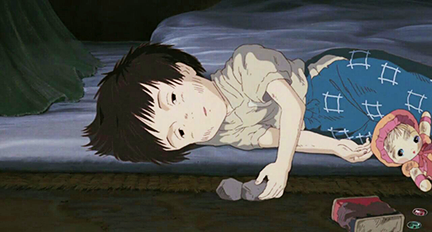
Likewise, another film critic, Ernest Rister noted that the film is the most profoundly human animated film he had ever seen: “This is to animation what Schindler’s List was to Spielberg – both a long overdue display of artistic maturity and a bold statement of ability”. Mark Seldon (2014) also described the film as one of the “notable exceptions to the literary and artistic silencing of the firebombing”. Moreover, as Illan Nguyên noted, the film was broadcast at the Annecy International Animated Film Festival, the world’s oldest and largest animation film festival, in 1991. There are only a few educational animations other than this film, and hence, it has been broadcast at least once every two years on the national television, ARTE in France which is similar to Kinyō Roadshow in Japan. Again, the film does not show audience any combat scenes of the war but the story of a family, and therefore, it is acceptable and suitable for peace education not only in Japan but also all over the world.
Conclusion
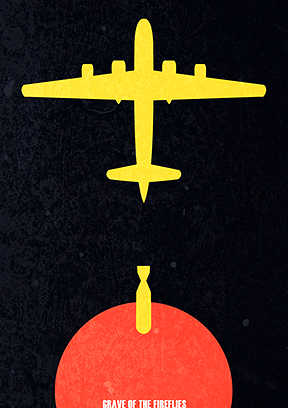
We examined the film “Grave of Fireflies” directed by Isao Takahata in terms of peace research and education by paying special attention to the three types of ‘violence’ (physical, psychological, and structural violence) in the film. First, it was clarified that the bombing of Kobe was ‘direct physical violence’ as well as ‘indiscriminate bombing’ and a ‘war crime’ that killed civilians including women and children. Yet, it should be noted that Japan started the war and this is a case of the ‘vicious circle of violence’ that needs to be discussed in peace education. Second, it was analyzed that the aunt of the two children was responsible for the death of the siblings. Her abusive language and behavior demonstrated ‘psychological violence’ that made the children leave her house. The aunt’s worst guilt lies in the fact that she almost forced the siblings to leave her house and did not stop them, even though she was able to do so. The aunt’s language and behavior can be interpreted as a case of ‘bullying’ that resulted in the death of the victims due to psychological violence and could be criticized and discussed in the peace education program at school and home. Third, it was emphasized that the social structure, or ‘structural violence’, murdered the siblings. The government could not take appropriate measures against war orphans promptly, and hence, the aunt, the medical doctor, and the police had no choice but to forsake the suffering siblings. The economic inequity and social discrimination against the war orphans silently but surely killed the kids in the end. Simply, the Peace education through the animated film “Grave of the Fireflies” Physical, psychological & structural violence of war structural violence deprived the civilians of the right to live with human dignity. More fundamentally, the war itself should be blamed for the deaths of the sibling in the first place. Despite all these negative images and results of the bombing of Kobe city, is this movie really not an ‘anti-war film’? The physical, psychological and structural violence indicate that various types of violence are responsible for the death of the siblings. The negative image of the war as ‘violence’ causes an ‘anti-war’ sentiment inside the hearts of audience, and therefore, it is fair to assume that this film can be categorized as an ‘anti-war film’. Finally, this film can be watched for the purpose of remembering the Asia Pacific War as an important historical lesson not to be repeated in the future. This animation film as well as the original novel can be utilized as teaching material for peace education at home, school, and in the world.
“Grave of the Fireflies” one of the greatest war films
There are ancient Japanese cultural currents flowing beneath the surface of “Grave of the Fireflies,” and they’re explained by critic Dennis H. Fukushima Jr., who finds the story’s origins in the tradition of double-suicide plays. It is not that Seita and Setsuko commit suicide overtly, but that life wears away their will to live. He also draws a parallel between their sheltering cave and hillside tombs.
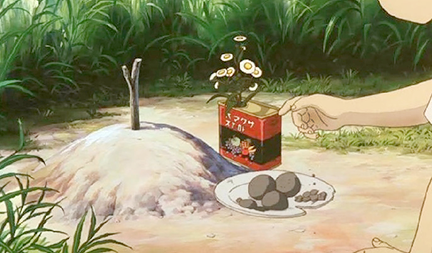
Fukushima cites an interview with the author, Akiyuki: “Having been the sole survivor, he felt guilty for the death of his sister. While scrounging for food, he had often fed himself first, and his sister second. Her undeniable cause of death was hunger, and it was a sad fact that would haunt Nosaka for years. It prompted him to write about the experience, in hopes of purging the demons tormenting him.”
Because it is animated and from Japan, “Grave of the Fireflies” has been little seen. When anime fans say how good the film is, nobody takes them seriously. Now that it’s available on DVD with a choice of subtitles or English dubbing, maybe it will find the attention it deserves. Yes, it’s a cartoon, and the kids have eyes like saucers, but it belongs on any list of the greatest war films ever made.
It may take another decade or two for the masses in America to realize this, and that may not happen until some brave filmmakers finally try to create neo-realist animation here. The prohibitive costs of creating animated films and the corporate mindset of Hollywood guarantee that this won’t happen anytime soon. That needs to change, because we deserve scores of movies influenced by Takahata and Grave of the Fireflies.
